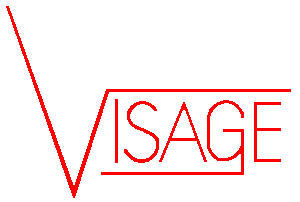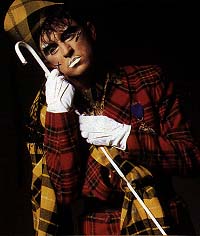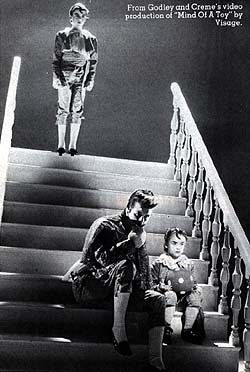

"Who can forget Steve Strange in 'The Damned Don't Cry'? This classic clip features Steve standing enigmatically on a thirties railway platform, a man haunted by his own achievements. We note Steve's enormous coat, which looks exactly like a military refrigerator-freezer. Smoke swirls around his ankles, but Steve dare not stir an inch, lest his coat bring him crashing to the ground. So there he stands- waiting, watching, slowly manufacturing ice cubes. Other points of interest in this tape include the birth of video surrealism- remember giant liquorice allsorts bounding down the stairs? chairs hanging from the ceiling? dolls-houses on fire? All this and more in 'Night Train', 'Fade To Grey', 'Mind Of A Toy', etc., etc."

People let themselves be confused so easily, and Steve Srange's
collective effort "Visage" will no doubt continue the distraction. Of
course, you should find out background info. if you like the music
and / or the film clip, but the crux of the matter always boomerangs
back to the movements on vinyl (at least until video equipment comes
in pocket-size).
On the initial score, Yes, I do like this album (except for the
childish 'Mind of a Toy') and recommend it to the listening public
(that's you beady-eyes). It's the old 'sophisticated' Euro-disco
pulse-beat, but the overall feel ranges from superlush to a less
common snappy grit&emdash;a transient but succinct statement of the
art.
One could rave on concerning the associated blaze fashion movement,
but you can read about that elsewhere. I guess some of you will
already be arranging 'Blitz Nights' at your very own clubs, while
others will just buy the album, enjoy the film clips and let the rest
of the business blow over, but maybe, just maybe, someone will
attempt to subvert this superficial popular momentum and make
something useful of this gaudy scene. - TYRONE FLEX
Stranger than Severn as it seems, the fact that Visage have burst
forth onto vinyl at the same time as Spandau Ballet is entirely
coincidental.
Musically, some would say it's predictable fare, what with the band
consisting of such talent as John McGeoch, Dave Formula and Barry
Adamson, ex and current Magaziners, Rusty Egan, and Midge Ure and
Billie Currie of Ultravox.
True, there's bound to be influences filtering through from those
camps, and in that sense there's no new barriers being broken nothing
so startlingly new that Ultravox the Orchestrals or Bowie haven't
tried it before.
The main point to Visage's advantage though, however contrary to
popular belief Is that there's nothing pretentious about the music or
Iyrics. It's mainly straight forward, commercial and danceable eu-
ro/electro disco, much more rock oriented than Spandau.
The Bowie influence often raises its head specially in 'Blocks On
Blocks', also YMOish in places, but strong on the com- mercial front.
Originality is present, especially from McGeoch, who winds his unique
way through 'The Dancer' with some atmospheric guitar sounds.
New single 'Fade To Grey', despite being a right rip-off of YMO's
'Femme Chihoise' with its soft French girly bits, is nevertheless a
slick disco dancer.
No surprises on Side 2, just a continuation of smart if not
innovative numbers. 'Malpaso Man' would make fine film theme musak,
being a paean to Clint Eastwood type perfect cool cowboys.
Lyrics are sensible, never obscure or meaningless. 'Moon Over
Moscow', all gay hussars and cossacks complete with Fiddler On The
Roof humming, feels like the Rus- sian version of Yellow Magic.
I'd like to say visage is bound to be played in all the right clubs
and discos, if there were any left to be seen in. - BETTY PAGE

Visage is the new package from England. And the package is a
fashion story. It's tha story of Steve Strange, the man who started
the Blitz Kids cult. Or as they're sometimes called, the Now Crowd.
Himself, Steve Strange is on record as preferring The Eighties Set.
Anyway, it all started at The Blitz Club at Covent Garden, in London.
At the Blitz Club you turned up as your own work of art. In Prince
Bonnie Charlie cloak and french beret, with green eyeliner and purple
lipstick.
Matching dutch clogs of course. And your girlfriend wore a 1935
wedding gown she'd found at the Hensley Church jumble sale. And
pretty soon, the newspapers called around. First the thrill and shock
merchants from The Sun. then the fashion columnists . . .
And suddenly it was a movement - an article in Time, lavish spreads
in Continental magazines from Stem to Paris Vogue. David Bowie
asksSteve Strange to play the clown in the video of Ashes to Ashes...
Coincidentally, the concept was picked up as a way of life by
suburban and out of London teenagers. Philip and Cathy, Barry and
Harry walk into their Claygate local after a two hour ritual dress
up, lounge around, have a few drinks. A defiant stand of colour in a
drab world of conformity. The Telegraph Sunday Magazine sends an
in-depth reporter to detail the void between dead-end daily jobs and
night time fantasies. The poignant conclusions are left hanging
unresolved, amidst decorative verbiage on The New Romanticism, The
New Darlings of Decadence, The Conventionality of Fashionable
Outrage, the New Order of Posing.
And quick, before it passes, get the record out.
Here it is, Visage, featuring Fade To Grey, the track with the
video-effects that psychedelia only dreamed about. Obviously
influenced by the first Roxy albums, Kraftwerk and Bowie's disco
period, Visage is a thoroughly listenable, cleverly produced,
effect-ridden, electronic rock album. Robotic beats, banks of varied
synthesisers, flattened vocals, and the message of terminally
repeated choruses. It is indeed a satisfactory example of modern
electronic disco. The latest studio-conceived environment of
chameleon sound. Turn it up, you can dance to it. Turn it down, it's
gently rhythmic background sound. And yes, even though the new
package bears a startling resemblance to some very age-old packages
indeed, in an important sense, it really is music of the late
'80s.
Y'see, Visage really belongs to the video disc era. - Anthony O'Gady
"...a bunch of fairly talented people pissing about in no apparent direction; this is what happens to extreme Roxy Music casualties when they grow up." - NME
"As a record this isn't that bad, but as a soundtrack for the bright young things it's not quite appropriate. It's neither dance music or a statement...It's unpretentious-strangely ordinary, like the 'movement' without it's clothes." - Melody Maker
"...the best context for it to be judged in is at full volume on a full dance floor." - Sounds
"...a highly listenable album of quality background music and the fruit of a useful collaboration amongst talented like-minded musicians." - Record Mirror
"...well crafted entertainment, eminently danceable and catchy." - Trousers Press
From the seedy dilettante to society queen, Steve Stranges regs to
riches story has warmed our hearts and lined his pockets. The new
Visage tune "The Damned Donít Cry" is tongue in cliche and
dull as dishwater.
Strange has the whole gang in on this one (R. Egan, M. Ure, B.
Currie, D. Formula and B. Adamson); they all give virtuoso
performances but the dreamy palpitations soon grind to a halt.
Strangeís sotto volce vocals eventually coagulate and turn the
record into an anhydrous lump of vinyl.
Inspired by the Luchino Visconti/Dirk Bogarde film "The Damned",
things might have been different if the cover featured the divine
Helmut Berger instead of .... No doubt the foggy video shown recently
on Riverside was immediately Betamaxed by a herd of Vidage fans who
will duly send the undeserving record high in the charts.
Follows a lenghthy review of Spandau Ballet's Diamond: While
Spandau Ballet aim for the Guadian, Visage are sticking with the Sun.
They are a sturdy business proposition - a kind of C.C.S. (remember
"Turn taps on the water, see the water flow"!) for today. Mickie Most
should look after their affairs.
Their latest LP "The Anvil" (Polydor) (called after New York's
infamous leather'n' bondage dive) is typically practical. It gives
the audience what it wants.
The cover has Steve Strange in the most recent Visconti production
outfits shot by the master of untrachic soft porn, Helmut Newton,
and, inevitably, Peter Saville came up with the funeral graphics. The
music is once again based around a big, electronic dance throb that's
now as old-hat as it is useful for clubs and parties. Wisely they
restrict their 'experimental' impulses to one item, "Whispers", which
being the last track can be happily ignored.
There is not much more to add. The songs are occasionally spiked with
brass and funk bass lines but nobody will mind. Steve Strange is a
worthy successor to the Sex Pistols for the cover of Investor's
Chronical as Young Businessman of the Year.
Ideally the dandy's roll is a combative one, which is why he was
oce compared with the soldier and the priest. The dandy's gesture,
his stylistic preoccupations, should alienate his audience and
distance him from the values od domesticity and straight society.
Let's forget Steve Strange once and for all, then, as a dandy: he's
too conventional for the role, too keen on the economic status quo
and eager to become part of the chique establishment of international
jet-setters.
Strange is the man who would be knig in this milieu, and if at one
point his lust for the hip life at the top had the potential for
certain selfish ironies (the lad from South Wales whose career
started as a punk cast-off in The Moores Murderers but who now get
invited to the right cosmopolitan parties with all the other rich
high profile social termites), it's too late for that now, because
Strange has succeeded too well - not with vengeance but with Visage,
a studio conglomerate whose first album in late '80 became the sound
for the right (often mythical) club and discos in '81. It was a
fragile, even tepid, sound (fading to grey). but it wasn't easily
dismissed because there was a vigorousness to it, largely due to the
tight but exploratory rhythms and syn-drum antics of Rusty Egan,
another quite hateful person.
The new album - and it galls me to say it, more than it does you to
hear it - is better than the first. It's more professional, more
danceable, much more of an exhortation to take to the floor than (a
random current example) the funkier stretches of Haircut's 'Pelican
West'. As for comparing Strange to his peers, those New Romantics who
made promises about "white European dance music". well he's streets
ahead of them and especially the ludicrous proposition which is
Spandau's latest work.
A lot of the credit, of course, must go to Visage - the team. Here,
you'll have to surmount yet more prejudices and forget the
pomposities of Billy Currie and Midge Ure on Ultravox's 'Rage in
Eden', because with Visage their keyboard and guitar dramatisations
work in a nicely cinematic, vulgar way. Thanks should also go again
to that Egan man - and Barry Adamson on bass, joined by another
ex-member of Magazine, Dave Formula on keyboards.
On 'Night Train', with the help of Gary Barnacle on sax, the team
actually get funky, working you up and working around each other. If
the band are usually more glacial than this, cuts like 'The Horseman'
and 'Anvil (Night Club School)' still have drive and strength. But
the vigour is always qualified: 'Move Up' (no 'Move on Up') may be
mobile music, but there's no aspiration, more a kind of ... dancing
on the spot.
'The Anvil' may be an album which invokes the disco, but even more it
wants to play in a hall of mirrors. At the same time as Visage invite
dance and motion, they also obsessively concern themselves with their
own reflection, with emotions whose superfiality borders on neurosis.
Here the Strange voice is very much part of the musical parcel, for
what else is it but a mellifluous whine, cpable of only a couple of
emotions and even more the luxury of feeling next to nothing? The
acheivement of 'Look What They've Done', 'Again We Love' and , to a
lesser extent, 'The Damned Don't Cry' (the current single and perhaps
the weakest song on the album), it to turn this heartlessness into a
form of sentimentality. 'Whispers' would be in this mould if it
didn't veer towards muzak and bad OMD.
'Wild Life' is the number which tries to reconcile Visage's danceable
tendencies with the neurosis and toy melancholy of their leader. It
can never be: the synths snarl with indifference and Strange's
nighlife manifesto is that of a paper tiger cut into dinky little
dollies. Maybe nobody will care too much about the failed attempt at
cruelty, at Emotion, becausr the packaging is just so - and that
means the assembling of another sort of team: Hair by Ollie, Clothes
by Anthony Price, Presentation by Peter Saville, and Photography by
Helmut Newton.
I'd thought 'Contort Yourself' the right kind of music for Newton's
sado-roticism, but 'The Anvil' is a greater approximation. You wanted
the moderne dance, well (forget your DAFs and Japans and Simple Minds
on Virgin's 'Methods of Dance' compiltation) here it is: the night
time moves of marionettes, dummies, puppets, clowns and imaginary
celluloid beings. It's all a little deathly, the sound of commodities
fucking, but a noise which can be a good deal more exhilarating ("the
sex appeal of the inorganic" - Walter Benjamin) than healthy
fun-loving creatures going at it.
All in all, Visage are a rather seductive disease, the skull beneath
the made-up skin. On this album they've produced the most consumate
backing tracks. Backing for what exactly? It's up to you to find out:
all I'll say is that if Roxy were still fired by their original
aesthetics, this is the kind of area they'd be covering - with alot
more flesh and humanity naturally. - Paul Tickell.
"Visage now resembles Ultravox with Currie and Ure imitating themselves." - Trouser Press
"The blandness is underwhelming. Some parts are pleasing, but others are heartless, overproduced, characterless slabs of wallpaper disco." - Sounds
"An excellent LP. Potentially as vital and influential in its field as the Human League's Dare." - Melody Maker.
"Visage aren't quite as bad as everybody remembers them. That is, of course, if anyone remembers them at all." - Melody Maker.
"Visage engendered an ugly, corrosive, collective mentality - the very antithesis of their necessarily vague manifesto...they come out of this retrospective album seeming as alluring as a bunch of red-nosed clowns, whose only tear was shed on the way to the bank." - Sounds.
"...electro-diskow at it's most vacuous... An overpainted speck on the history of pop and as they say, last year's make up was just some poor animal's bollocks." - Record Mirror.
It shows how quickly the music press turns on a scene they embraced at the time. Out of interest what did Sounds have to say about Ultravox's Lament album of the same year:
"Bland, tuneless songs ... 'Lament is nothing more than a flaccid placebo ... it's contents prove Ultravox to be little more than a pimple on the arse of the industry."


Created: 20/10/96
Modified: 26/6/97
Maintained by: Ashley Fletcher nwc@nerosoft.com